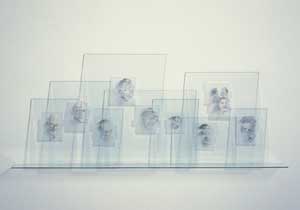Sollins’ ‘Last Portraits’ Make Art of Obituaries
by Kenneth Baker, THE SAN FRANCISCO CHRONICLE

Stephen Sollins mounted newspaper obituary photos on glass in "Last Portraits (March-October 1996)"
To fix someone in memory has always been the purpose of portraiture. But how does portraiture figure in a culture that likes its images fast, cheap and disposable, as ours does?
See the “Last Portraits” by New York artist Stephen Sollins at Gross.
Sollins raided the New York Times obituary pages for portraits, both verbal and pictorial, from March to October 1996.
The exhibitions title piece, “Last Portraits (March-October 1996)” (1997-98), is a large installation of glass panels leaning on glass shelves. Each glass rectangle holds a fragmentary newsprint photograph lifted from the title page with Scotch tape. The nameless faces seem to fade with time as we look at them, their anonymity not at all offset by the part they now play in a work of art.
Anyone who knows Christian Boltanski’s installations of scavenged photographic portraits will think of them here. But where the Holocaust is always a reference point for Boltanski, Sollins’ work is about the lack of any such moral fulcrum in American public memory.
In his “30 Drawings” (1997), Sollins finds skeletal poems in the lay of words in obituaries. Again using tape transfer, he has lifted out individual words or phrases from different places and positioned them on blank sheets exactly as he found them.
Some are quietly elegiac: “A Previous marriage/divorce,/a son.” Others are almost distastefully funny: “Memorial/ A memorial/ He died.” One, though implicitly critical of the obit writer, has a keening urgency: “Fire/ fire/ fire/ fire/ fire/ fire/ fire/ fire.”
The refinement of Sollins’ work and his subjects’ anonymity inspire the odd thought that, in our culture, good aesthetics may now be the most unique, respectful tribute.
